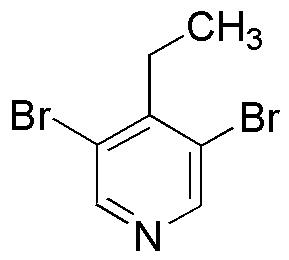3,5-Dibromo-4-ethylpyridine is widely utilized in research focused on:
- Pharmaceutical Development: This compound serves as a key intermediate in the synthesis of various pharmaceuticals, particularly in developing drugs with anti-inflammatory and antimicrobial properties.
- Agricultural Chemistry: It is used in the formulation of agrochemicals, including herbicides and pesticides, helping to enhance crop protection and yield.
- Material Science: The compound is explored for its potential in creating advanced materials, such as conductive polymers, which are essential in electronics and energy storage applications.
- Biochemical Research: Researchers utilize it to study enzyme interactions and cellular processes, aiding in the understanding of biological mechanisms and disease pathways.
- Environmental Applications: It is investigated for its role in developing environmentally friendly solvents and reagents, contributing to sustainable chemistry practices.
General Information
Properties
Safety and Regulations
Applications
3,5-Dibromo-4-ethylpyridine is widely utilized in research focused on:
- Pharmaceutical Development: This compound serves as a key intermediate in the synthesis of various pharmaceuticals, particularly in developing drugs with anti-inflammatory and antimicrobial properties.
- Agricultural Chemistry: It is used in the formulation of agrochemicals, including herbicides and pesticides, helping to enhance crop protection and yield.
- Material Science: The compound is explored for its potential in creating advanced materials, such as conductive polymers, which are essential in electronics and energy storage applications.
- Biochemical Research: Researchers utilize it to study enzyme interactions and cellular processes, aiding in the understanding of biological mechanisms and disease pathways.
- Environmental Applications: It is investigated for its role in developing environmentally friendly solvents and reagents, contributing to sustainable chemistry practices.
Documents
Safety Data Sheets (SDS)
The SDS provides comprehensive safety information on handling, storage, and disposal of the product.
Product Specification (PS)
The PS provides a comprehensive breakdown of the product’s properties, including chemical composition, physical state, purity, and storage requirements. It also details acceptable quality ranges and the product's intended applications.
Certificates of Analysis (COA)
Search for Certificates of Analysis (COA) by entering the products Lot Number. Lot and Batch Numbers can be found on a product’s label following the words ‘Lot’ or ‘Batch’.
*Catalog Number
*Lot Number
Certificates Of Origin (COO)
This COO confirms the country where the product was manufactured, and also details the materials and components used in it and whether it is derived from natural, synthetic, or other specific sources. This certificate may be required for customs, trade, and regulatory compliance.
*Catalog Number
*Lot Number
Safety Data Sheets (SDS)
The SDS provides comprehensive safety information on handling, storage, and disposal of the product.
DownloadProduct Specification (PS)
The PS provides a comprehensive breakdown of the product’s properties, including chemical composition, physical state, purity, and storage requirements. It also details acceptable quality ranges and the product's intended applications.
DownloadCertificates of Analysis (COA)
Search for Certificates of Analysis (COA) by entering the products Lot Number. Lot and Batch Numbers can be found on a product’s label following the words ‘Lot’ or ‘Batch’.
*Catalog Number
*Lot Number
Certificates Of Origin (COO)
This COO confirms the country where the product was manufactured, and also details the materials and components used in it and whether it is derived from natural, synthetic, or other specific sources. This certificate may be required for customs, trade, and regulatory compliance.


